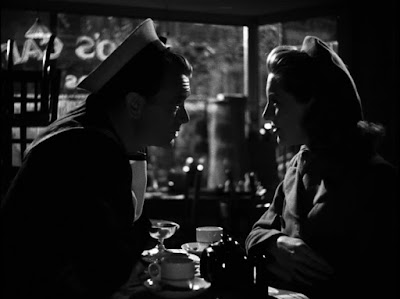As museums and galleries are still locked down here are some memories from the past...
1) THE LAST JUDGEMENT (detail) (1435-1440) - Fra Angelico
I
bought this at the Gemaldegalerie in Berlin where Fra Angelico's impressive triptych of the Day of Judgement is on display. The central panel is Christ triumphant surrounded by his sainted besties and on the left panel he shows those blessed with life eternal and on the right those being tortured in Hell. It possibly needs renovating to bring the painting back to what one assumes was it's vibrant life.
The postcard features a detail from the left panel where those bound for Heaven are being led by dancing angels; the flowing robes are beautifully realised in such tiny detail and they really stand out against the dark background as do the tiny buds and shrubs.
2) THE ANNUNCIATION (1440 - 1445) - Fra Angelico
This
came from the San Marco monastery in Florence which is the home of this fresco, one of Fra Angelico's two masterpieces showing The Annunciation, the other is in the Prado. In one of the great moments of "art theatre" you ascend the wide staircase to the first floor of San Marco where the monks' cells are located and as you turn the corner, you see this large fresco facing you at the top of the staircase - a real wow moment.
Fra Angelico, through the held gaze between the Angel Gabriel and The Virgin Mary, creates a captured moment of being; there is nothing to distract from the intensity of that moment, you believe the world has stopped outside. It is marvellous to stand and revel at it's detail: the intricate painting of the relief at the top of the portico's pillars which give the image a perspective that breaks with the traditional flat look of Gothic paintings, the vivid pink and gold of Gabriel's robe is contrasted against Mary's blue cloak and his lovely multi-coloured wings also contains intricate detailing. It's interesting how the flat rendering of the garden is offset by the depths of the trees beyond the fence.
3) THE TOWNEY DISKOBOLOS (circa 2nd Century AD) - unknown
This
marvellous Roman marble statue was discovered near Hadrian's villa in Tivoli in 1791 and later acquired for the British Museum. It is based on a now lost bronze statue, sculpted in the 5th Century BC by the Greek artist Myron.
When it was found, the statue was missing it's head but when it was purchased by Charles Townley he was told that the head had been found nearby. Down the years there has been much conjecture as to whether it actually was the original head as another marble statue had been found a few years before with the athlete's head turned looking at the discus. Whatever it's genesis, it is still a wonderful rendering of the athlete about to launch his discus into the void.
4) THE BROKEN COLUMN (1944) - Freda Kahlo
One of the most famous and revealing of Frida Kahlo's self-portraits, she painted it in 1944 after she had spinal surgery to correct the injury she received 19 years before in a trolley-bus crash I bought this in 2005 at Tate Modern when they had a major retrospective of her work.
Frida stands alone, impassively staring out at the viewer in a landscape that is as broken and split as her body. Her torso is cracked open to reveal a broken but still-standing stone column instead of her spine. She wears the cumbersome harness that doctors had her wear to correct her posture and her body is pierced with nails as in her own crucifiction. Although there are tears on her face, she is still standing, still surviving.
5) PORTRAIT OF A GIRL WEARING A BLUE JERSEY (DORA CARRINGTON) (1912) - Mark Gertler
Bought at the marvellous CRISIS OF BRILLIANCE exhibition at the Dulwich Picture Gallery in 2013 which brought together six contempories who studied at the Slade Art School in the 1910s: Bomberg, Nevinson, Spencer, Nash and, as seen here, Mark Gertler and his subject Dora Carrington.
Through his arresting portrait you can feel Gertler attempting to capture the quicksilver modernity of Carrington, then aged 19, with her placid but determined stare, her self-cropped hair and the cool tones of her blue jersey against the sky. Gertler was to become obsessed with Carrington only to find that CRW Nevinson was also pursuing her. Carrington, however kept them both at arm's length, wanting their friendship but not sex. She later gave in to Gertler's persistance but it left them both unhappy and they kept a distant friendship afterwards. Carrington committed suicide in 1932 in despair after the death of Lytton Strachey, the love of her life, and Gertler killed himself in 1939, lost in a swell of depression.






















































